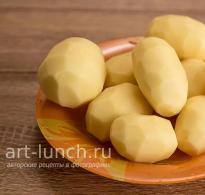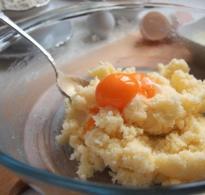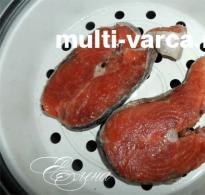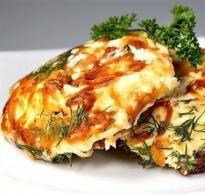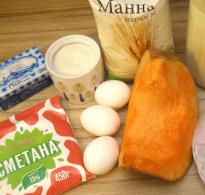What is banosh? Banosh: recipe in a slow cooker
Do you know how to cook banosh in Transcarpathian style - corn porridge with sour cream? It's not that difficult, and the ingredients you need are simple and accessible, and you will need a little time... But what a great dish you will get in the end! Firstly, banosh is very beautiful and appetizing, even if you don’t want to eat, it will be quite difficult to resist trying the bright, sunny yellow banosh porridge.
Secondly, as I already said, banosh is prepared with sour cream, and therefore it turns out incredibly satisfying and nutritious. For a hearty breakfast - exactly what you need. And thirdly, corn porridge is very healthy, it contains a lot of vitamins and nutrients, it is even recommended for baby food because it does not cause allergies.
So, as you can see, the recipe for banosh with sour cream has a lot of advantages, so not trying it is simply a crime. Well, after trying banosh once, you will surely fall in love with it, like I did. So, how to prepare banosh at home - a step-by-step master class especially for you!
Ingredients for 2 servings:
- 100 g fine corn grits;
- 200 g homemade sour cream;
- 150 ml water;
- 100 g feta cheese;
- 20 g butter;
- salt to taste.
How to cook Transcarpathian-style banosh at home:
To prepare banosh in Zakarpattia style, you need fine corn flour, the size of semolina. Larger grains will take much longer to cook, a completely different amount of water will be required to prepare them, and the resulting banosh will have a completely different taste and not such a bright color.

Pour water at room temperature into a thick-bottomed saucepan and add the cereal. Mix and put on fire.

Over medium heat, bring the contents to a boil, then reduce the heat to minimum (it’s good if you have a divider) and cook, stirring, for 10 - 12 minutes, until almost done. Since there is not enough water for such a quantity of cereal, be sure to stir all the time so that the porridge does not burn. By the end of cooking, the porridge will become too thick, but do not add water.

Add sour cream to the porridge and mix thoroughly. Add salt to taste.

Place the pan with the porridge on the lowest heat and simmer for 5-7 minutes, stirring, until fully cooked. Droplets of fat appear on the finished porridge; it easily moves away from the walls of the pan. Place butter in the jar and mix. Leave in the pan, covered with a lid, for 10 minutes to allow the banosh to brew.

Grate the cheese on a medium grater. Serve the banosh hot, sprinkled with grated cheese.

With the indicated proportions of ingredients, the banosh turns out to be quite thick. If you want a thinner consistency, increase the amount of water to 175 ml.
Hutsul traditions attract ordinary people with their mysteries and secrets. One has only to remember the famous film by Sergei Parajanov “Shadows of Forgotten Ancestors”, as images of the mountain Carpathians, clear springs, birch trembita and forest makos that hide among the trees and lure random travelers into their arms appear in our imagination. It is among this pristine beauty that people live who wear embroidered clothes, raise sheep and, of course, cook in a cauldron the traditional dish for this region - banosh. The smell of a fire certainly gives it a special charm. But if you prepare this dish at home, it will be no less tasty.
Secrets of Banosh
There is nothing complicated in preparing the dish. Banosh, the recipe for which was invented by the Hutsuls, is the soul of their cuisine. This unique porridge is cooked in milk, cream or sour cream. For Western Ukraine and nearby regions of Romania, the dish is everyday; it often appears on the tables of local residents. If you visit the Transcarpathian region, the historical homeland of banosh, you will be able to taste porridge not only in any restaurant, but also when visiting locals. The residents here are very welcoming and always welcome visiting tourists.
The dish is especially popular in the Rakhiv region. Every year a festival dedicated to banosh is held here, where you can try different variations of porridge. It used to be considered a poor man's dish. Almost all the locals raised sheep. And banosh was prepared when there was nothing edible left in the house except a handful of cereals and a couple of spoons of sour cream. Today, not a single chic feast or wedding in the Hutsul style is complete without this delicacy.
Subtleties of cooking
If you come to the Carpathians, you will find only men preparing this dish. “Porridge does not tolerate women’s hands,” the Hutsuls joke, mysteriously conjuring over a huge pot with a bubbling delicacy. The thing is that sheep farming is the traditional work of the stronger sex, therefore dishes associated with it automatically become the prerogative of the heads of families.

Banosh porridge, the recipe for which is sacredly kept in any Hutsul family, is imbued not only with smoke from the fire, but also with various legends. They say that they named it after the local Hutsul. A long time ago, Gazda Banosh lived in these places, known throughout the area for his love of work. After a hard day of work spent in the field, he came home, where his wife brought him a nutritious meal to restore strength and energy - corn porridge, seasoned with aromatic pieces of lard sizzling after the fire. At the same time she kept saying: “Eat, Banosh, eat.” This is where the name of the delicacy came from: it was immediately picked up by locals and, spread throughout the area, it quickly took root in every Transcarpathian house.
Main Ingredients
If you want to pamper your household with a traditional Hutsul dish, then prepare banosh with milk. The recipe includes the following main components: 400 grams 100 gr. sheep cheese - feta cheese, 50 gr. smoked lard. The basis is usually sour cream and milk - 250 ml each, but instead of the latter you can safely use cream. The main thing is that they are not store-bought, but completely homemade, natural.
Corn flour must be sifted through a sieve. It is ideal if it is finely ground, in which case the porridge will turn out more homogeneous and tender. It is advisable to use not fresh sour cream: it is better if it sits in the refrigerator for two or three days beforehand. The Hutsuls kept it in a barn so that it would not go sour. We don’t have such a room, so in a pinch, a balcony will do, unless, of course, it’s +30ºС outside the window. By the way, banosh is seasoned with lard cracklings, but you can additionally use dill or paprika as a seasoning to taste.
Classic banosh
This dish includes all of the above ingredients, the proportions of which are designed for two people. A classic recipe is provided for cooking in cauldrons. According to it, Hutsul banosh is prepared with sour cream from sheep's milk. You can replace this component with cream: it will not spoil the taste, but, on the contrary, will add some zest to the dish.

Let's start with something simple. We dilute the sour cream with a small amount of water or vegetable broth, pour it into a cauldron and bring to a boil. Next, take corn flour: pour it into the cauldron in a small stream, constantly stirring the liquid so that it does not burn. Add salt and pepper to taste. The porridge is considered ready when it has reached a thick consistency and looks like semolina. After this, use a wooden spoon or ladle to place it in deep plates, sprinkle on top with feta cheese, previously finely crumbled, as well as cracklings - small pieces of lard, fried in a frying pan until crusty. You cannot mix the ingredients. The dish should be served hot.
Ingredients for banosh in a slow cooker
Unfortunately, we don't live in the mountains. For an ordinary city person, fires and kettles are available only in rare cases: during a hike or while relaxing in the village. Therefore, in order to prepare a tasty dish, modern people have to make some adjustments to the classic recipe. Banosh with feta cheese is delicious and, of course, very healthy. But it is not always possible to find it in city supermarkets and markets, so it can be replaced with the usual one: hard Russian or Dutch, as well as melted.

Based on this, we will need the following components:
- 600 gr. milk.
- 450 gr. homemade or purchased sour cream (20% fat).
- 450 gr. corn grits (about 3 multi-cups).
- 200-300 gr. feta cheese or other cheese.
- 100 gr. lard
- Butter and vegetable oil.
- Salt and pepper.
If for some reason you do not eat lard, you can replace it with mushrooms. They go perfectly with cheese and corn porridge. Using regular champignons, you can cook mushroom banosh. The recipe for cooking in a slow cooker will be slightly different from the classic version.
Basic recipe
Turn on the multicooker, setting it to the “Frying” mode. Pour a little vegetable oil (40-50 g) into the bowl. While it is heating up, finely chop the onion. It is not necessary to use it, but since we do not have a cauldron that gives the dish a specific taste, we try to add zest in another way. And the bow is perfect for this purpose.

Grate the cheese. We cut the champignons into slices. First add the onion to the boiling oil. After it acquires a golden hue, add mushrooms to it and saute them together. When the ingredients release their juice, transfer them to a separate bowl. Wash the multicooker bowl thoroughly and pour the cereal into it. Add milk, sour cream and spices. Select the “Buckwheat” mode and cook the porridge for 35 minutes. When the time is up, using the “Heating” function, simmer our banosh for 30-40 minutes. The recipe in a slow cooker is designed so that the porridge will end up crumbly and sufficiently boiled. Place it, hot and freshly prepared, on plates, grease with butter, sprinkle with cheese and place mushrooms and onions on top.
Other types of banosh in a slow cooker
Our imagination is the source of new variations of the dish. Don't be afraid to experiment to make banosh to your liking and in your own personal interpretation.
To prepare porridge, first you need to rinse it thoroughly under running water and pour it into a slow cooker. Pour a mixture of milk and sour cream on top of the cereal, adding sugar and salt to taste. By the way, if the device does not have the “Buckwheat” function, then you can cook porridge using other modes: “Milk porridge” or “Stewing”.
While the porridge cooks in a slow cooker for half an hour, fry onions and carrots in a frying pan, as well as diced brisket or minced meat. Place the meat filling on top of the porridge. By the way, women also often use cottage cheese. The product has those qualities that make banosh cooked in a slow cooker as healthy and nutritious as possible. The recipe with mushrooms and feta cheese makes it possible to prepare an amazingly tasty dish. But with cottage cheese, the porridge turns out no less appetizing.
Meet Banosh's "brother" - Tokan
Very often these two dishes are confused or considered that there is no difference between them. But this is a grave mistake. Banosh and Tokan are indeed very similar, but fundamental differences between them still exist. Firstly, tokan is cooked in water. A layer of porridge, placed in a multicooker bowl, is filled with water or light and cooked for 30-40 minutes. Due to the absence of a sour cream base, such a dish is lighter and less caloric.

Secondly, the filling in the tokan is not laid out on top, but between the layers of porridge. That is, part of the finished cereal is transferred to a dish, sprinkled with feta cheese, grated cheese or cottage cheese. Next comes another layer of porridge. Pour the remaining filling and some cracklings fried in a frying pan on top. There can be as many layers of tokan as you like, and the more there are, the tastier the dish turns out. Thirdly, the Banosh is a native of the Rakhiv region of Transcarpathia. The tokan recipe is more used by residents of the neighboring Tyachiv region of the same Ukrainian region.
Benefits of banosh
The main component of the dish is corn grits, which are rich in fiber. It perfectly cleanses the intestines, while preventing the development of putrefactive processes in the body. The selenium it contains protects against stress and slows down aging. Porridge is recommended for children and elderly people, as it contains a large amount of carotene and strengthens the immune system. It also does not cause allergies.

Banosh, the recipe for which is described above, is useful for people suffering from anemia. It contains vitamins E and B12. Pregnant women, who often suffer from a lack of folic acid, simply cannot do without porridge on the menu. It should be the basis of their diet. Banosh also contains magnesium, potassium and phosphorus - microelements that contribute to the normal functioning of the cardiovascular system.
But it is worth noting that with all the advantages of the dish, it also has a number of contraindications. Thus, banosh is very high in calories, so it is not recommended for people prone to obesity and those with high blood cholesterol levels. It is also prohibited for patients with problems with the gastrointestinal tract.
Banosh (banush) is a traditional and very tasty dish of Ukrainian Hutsul cuisine. This is not hominy, polenta, gomi, or simple corn porridge. At first glance, a simple and unpretentious dish represents a whole ritual in preparation.
Firstly, according to the rules, only men can cook banosh. The best option for preparing the most delicious banosh is over a real fire in a cauldron high in the mountains. They say that a banosh should be saturated with smoke and gain fire. Of course, in our conditions this is not available to many people.
Secondly, a delicious banosh is prepared preferably with homemade sour cream, which has been left for 3 days in a cold place. Banosh should be a little sour - this is its highlight. Do not replace homemade sour cream with cream - it will turn out completely different. Sour cream can be diluted quite a bit with milk or water.
Thirdly, banosh is a simply magical dish. According to legend, banosh should be stirred in one direction only with a wooden spoon. An iron spoon will not give the desired taste. Banosh himself will tell you when he is ready. You must stir the dish until droplets of oil appear on the walls of the cauldron or pan, as well as on the surface of the banosh. It is at this moment that the banosh changes dramatically and turns from a sticky and liquid porridge into a smooth, tender deliciousness sliding along the walls, which follows the wooden spoon in the pan, repeating all its movements. At this moment they say that “the banosh is dancing.”
Banosh is often prepared in Hutsul families, since each family consists mainly of 6 or more people. Every day they all have to do everyday hard work: mowing, plowing, hauling hay, chopping wood, herding sheep, picking mushrooms and berries. And all this in the mountains, when your closest neighbor can live 800 meters above you and getting to any point in the village is not so easy.
And banosh is easy and simple to prepare. It is filling, nutritious and delicious. Banosh is served with sheep cheese, cracklings, and sometimes with fried mushrooms. There are many banosh recipes. It may be thicker or more liquid. If you like a more liquid banosh, add less corn grits per suggested amount of liquid. Bon Appetit everyone!
In Transcarpathia, real banosh is cooked over a fire so that it is saturated with the aroma of smoke. But in our urban conditions this is quite problematic, and I decided to try cooking it in my trusty assistant, the multicooker, since all grains cook perfectly in it, and corn is no exception.
Banosh is often cooked with liquid sour cream mixed with milk. I didn’t want a sour taste, and so I decided to replace the sour cream with heavy cream. You can do the same, mix cream with water, sour cream with milk or water, in general, there are a lot of options - experiment!
Pour milk and cream into the multicooker and turn on express mode so that it boils faster, add plenty of salt. As soon as the boiling begins, switch to the stewing mode and add corn grits.

Now cook, stirring constantly so that the cereal does not burn, until completely cooked. It depends on the cereal, but on average it takes from 15 to 30 minutes, try it. The finished banosh should have a semi-liquid consistency, like semolina porridge.

While it's cooking, prepare the cracklings. For them, I took the lard from the underbelly and cut it into fairly thick slices. Fry the lard in a frying pan until golden brown. The amount of lard is also up to you; you can take more if you like lard. Pour the finished banosh into a bowl, sprinkle with cracklings and pieces of fresh cheese. I also added fresh black pepper.
In our article we want to talk about such a dish as Transcarpathian banosh. The recipe for preparing traditional Transcarpathian food is quite simple, so even the most inexperienced housewife can handle it. But let's talk about everything in order... What kind of dish is this and how to cook it correctly?
What is banosh?
The recipes of our ancestors are sometimes unfairly forgotten by us, giving way to new fashionable dishes. But our grandmothers had simple, but incredibly tasty and healthy dishes in their arsenal. Tourists vacationing in the Carpathians have probably heard from the locals and even tried banosh in a cafe (the recipe is given in the article below).
The unusual name hides a traditional Transcarpathian dish made from corn grits. Real banosh is cooked over a fire, which is why it has a special aroma. It is served with cracklings, mushrooms and cheese. In the old days, such food was considered the lot of the poor, because they always had cornmeal and sour cream in stock, since each family had its own cow, and therefore dairy products.
What products are used to prepare the dish?
They say that the most delicious banosh (the recipe is given in the article) can only be tasted in the Carpathians. Here it is prepared with homemade sour cream from sheep's milk and cheese. Moreover, they do not use fresh fermented milk product, but three-day-old sour cream from the cellar.

If anyone is interested in trying this dish, then you can cook it yourself. Of course, you will have to slightly modify the recipe for banosh with sour cream, since in urban conditions it is unlikely that you will be able to find fermented milk products made from sheep’s milk. To prepare, you can use homemade cow cheese and sour cream. If you can’t find homemade fermented milk products, you can buy heavy cream at the store. It is better not to use factory-made sour cream, as it has an acidity that can spoil the taste of food.
In addition, during cooking it is necessary to use a wooden spoon, but it is better not to use a metal one (metal gives a sour taste). If you want to get a real banosh (the recipe is given in the article), then it is better to stock up on fine corn grits or flour. An ordinary saucepan is not suitable for preparing such a dish. The most delicious porridge is made in clay pots and cast iron pots.
Banosh: recipe with photos (step by step)
To prepare the dish we will need the following products:
- A glass of corn flour (or fine corn grits).
- Half a glass of water.
- 1.5 cups sour cream (necessarily homemade).
- 170 g feta cheese.
- Greenery.
The sour cream must be transferred to a cauldron and diluted with water, lightly salted and brought to a boil. Next, add flour in a very thin stream and stir constantly with a wooden spoon until thickened. The finished porridge should lag behind the walls of the dish, and fatty droplets of oil should appear on its surface. The dish is served in clay pots or bowls, sprinkled with herbs.

So our Transcarpathian-style banosh is ready. The recipe with photographs will help you understand the nuances of preparing the dish.
Banosh with feta cheese
Banosh with feta cheese has an original taste. To prepare it you need to take:
- Cream or homemade sour cream - 0.4 l.
- Glass of water.
- Corn flour or grits - 0.2 kg.
- Brynza - 0.2 kg.
- Butter - 40 g.
- Salt.
We put the pan on the fire, pour in water and let it boil, after which we immediately add corn flour and add salt. Cook the porridge, remembering to stir constantly. When the banosh is almost ready, add sour cream and continue stirring. Add oil to the prepared porridge and let it brew. Meanwhile, we grind the cheese. Serve the dish hot, sprinkling cheese cheese on top. The consistency of banosh can be very thick or more liquid, it depends on the amount of water you pour during cooking.
History of the dish
Banosh, polenta, hominy are the names of very similar dishes that are prepared on the basis of corn porridge of different grinds (from the finest to coarse). The differences between the dishes are quite insignificant - cooking time, sauces, fat content, etc. Not only Hutsuls, but also Hungarians consider Banosh their national dish.

An interesting fact is that banosh, like feta cheese itself, has long been prepared only by men, since sheep-making is an exclusively male activity. The Hutsuls say that a dish prepared at home, in a cafe or restaurant has nothing in common with real corn porridge. After all, banosh should be cooked over a fire and smell of smoke. They say that in Transcarpathia every man has a special place in his yard for cooking porridge. This everyday dish is prepared several times a week. Be that as it may, at home we can also prepare quite tasty porridge, albeit not quite real, but banosh.
Banosh with bacon
To prepare porridge with bacon we will need:
- Corn grits - 0.2 kg.
- Bacon - 100 grams.
- Homemade sour cream (sour cream can be replaced with cream) - 0.5 kg.
- Homemade cheese - 60 grams.
- Salt.
Pour cream or sour cream into a cast iron cauldron and bring to a boil. If desired, you can add a little water. Next, slowly add corn flour and constantly stir the contents of the cauldron until thickened. Remember, real banosh should not be too thick. In the meantime, cut the lard into strips or bacon and fry in a frying pan until cracklings form.

Remove the banosh from the heat the moment shiny droplets of oil appear on the surface. The dish is served hot and sprinkled with pieces of cheese and cracklings on top. Banosh should only be eaten fresh. Porridge goes well with lightly salted cucumbers.
Banosh with mushrooms
Banosh can also be prepared with mushrooms. To do this, bring the sour cream to a boil and add corn flour, adding salt and sugar. During cooking, you need to constantly stir the porridge until it thickens. Next, reduce the heat and persistently rub the banosh until oily spots appear on the surface. Experts say that the main secret of preparing such porridge is that it needs to be stirred with a wooden spoon in only one direction.

A ready-made, properly cooked banosh should have the consistency of semolina porridge and at the same time easily pull away from the walls of the dish.
All kinds of additives for the dish are prepared separately. Mushrooms can be used as an additional component that significantly diversifies the taste of the porridge. They are soaked and fried in the lard that remains after cooking the greaves. In addition, you can add grated cheese, which melts in the hot porridge and gives a wonderful taste.

The finished dish is served hot, layered with ingredients: banosh, feta cheese, cracklings and mushrooms. The porridge is eaten without stirring. You can decorate it with fresh herbs on top.
Instead of an afterword
In our article we tried to talk about the options for preparing the Hutsul dish banosh. The recipe with photos will help you understand the preparation of this simple dish. Corn porridge is a very nutritious and high-calorie dish that satisfies hunger well and for a long time. Such food was once prepared by poor people in Transcarpathia from the products that were always at hand. But now the dish is rather considered a local highlight. In every courtyard, the hostess who receives guests who come to the Carpathians certainly prepares such porridge for her guests.

